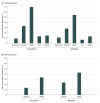Estimated Prevalence of Nonverbal Learning Disability Among North American Children and Adolescents
- PMID: 32275324
- PMCID: PMC7148441
- DOI: 10.1001/jamanetworkopen.2020.2551
Estimated Prevalence of Nonverbal Learning Disability Among North American Children and Adolescents
Abstract
Importance: Nonverbal learning disability (NVLD) is a neurodevelopmental disorder characterized by deficits in visual-spatial processing but not in reading or verbal ability; in addition, problems in math calculation, visual executive functioning, fine-motor skills, and social skills are often present. To our knowledge, there are no population-based estimates of the prevalence of NVLD in community samples.
Objective: To estimate the prevalence of the NVLD cognitive profile in 3 independent samples of children and adolescents from studies centered around brain imaging in the US and Canada.
Design, setting, and participants: This cross-sectional study used data from 2 samples recruited from the community and overselected for children with psychiatric disorders (Healthy Brain Network [HBN], January 1, 2015, to December 31, 2019, and Nathan Kline Institute-Rockland Sample [NKI], January 1, 2011, to December 31, 2018) and 1 community-ascertained population sample (Saguenay Youth Study [SYS], January 1, 2003, to December 31, 2012) overselected for active maternal smoking during pregnancy.
Main outcomes and measures: Prevalence of NVLD. Criteria for NVLD were based on clinical records of deficits in visual-spatial reasoning and impairment in 2 of 4 domains of function (fine-motor skills, math calculation, visual executive functioning, and social skills). Sample weighting procedures adjusted for demographic differences in sample frequencies compared with underlying target populations. Inflation factor weights accounted for overrepresentation of psychiatric disorders (HBN and NKI samples).
Results: Across 3 independent samples, the prevalence of NVLD was estimated among 2596 children and adolescents aged 6 to 19 years (mean [SD] age, 12.5 [3.4] years; 1449 male [55.8%]). After sample and inflation weights were applied, the prevalence of NVLD was 2.78% (95% CI, 2.03%-3.52%) in the HBN sample and 3.9% (95% CI, 1.96%-5.78%) in the NKI sample. In the SYS sample, the prevalence of NVLD was 3.10% (95% CI, 1.93%-4.27%) after applying the sample weight. Across samples and estimation strategies, the population prevalence of NVLD was estimated to range from 3% to 4%. When applied to the US population younger than 18 years, 2.2 million to 2.9 million children and adolescents were estimated to have NVLD.
Conclusions and relevance: The findings suggest that the prevalence of NVLD in children and adolescents may be 3% to 4%. Given that few youths are diagnosed with NVLD and receive treatment, increased awareness, identification of the underlying neurobiological mechanisms, and development and testing interventions for the disorder are needed.
Conflict of interest statement
Figures


Comment in
-
The Importance of Defining Shared Criteria for the Diagnosis of Nonverbal Learning Disability.JAMA Netw Open. 2020 Apr 1;3(4):e202559. doi: 10.1001/jamanetworkopen.2020.2559. JAMA Netw Open. 2020. PMID: 32275318 No abstract available.
References
-
- Johnson DJ, Mykelbust HR. Learning Disabilities: Educational principles and practices. New York: Grune & Stratton; 1967.
-
- Rourke BP. Nonverbal Learning Disabilities: The Syndrome and the Model. Guilford; 1989.
-
- Casey JE, Rourke BP. Construct validation of the nonverbal learning disabilities syndrome and model In: Rourke BP, ed. Neuropsychological Validation of Learning Disability Subtypes. Guilford Press; 1991:271-292.
Publication types
MeSH terms
Grants and funding
LinkOut - more resources
Full Text Sources
Medical

